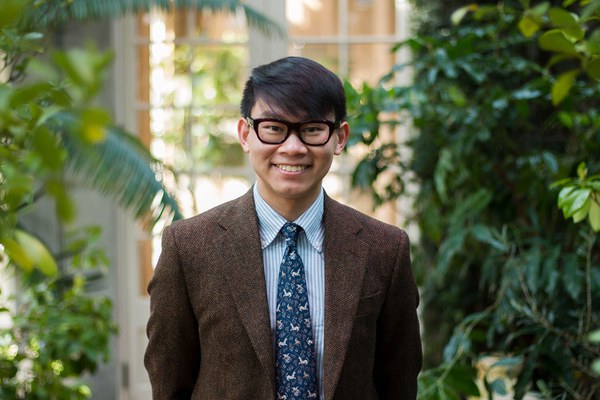Viet Cuong, whose compositions have been played on six continents and at Carnegie Hall, Lincoln Center, the Kennedy Center, and the Library of Congress, was the spring 2020 early-career musician resident. His research report, “Percussive Collaboration: The Making of Sandbox, Well-Groomed, and Re(new)al,” illuminated the process of making whimsical and unexpected contemporary music.
Q&A with Viet Cuong
Why incorporate elements of childhood or the home into your work?
I like to have a sense of whimsy or playfulness in my music. On some level, it’s because it’s charming and a way to bring joy to people who are listening. But I also like to give people something relatable they can grasp. Many people know what it feels like to do a toast—they know what it’s like to hold a wineglass and toast it with someone else. They also might know the sound that’s produced when you run your finger across the rim of a glass.
Using these elements can almost make the audience members feel like they could perform the piece, and I think this can help contemporary music concerts feel less stuffy. Many people don’t know what it’s like to hold a percussion mallet, so they think, “I could never possibly do that, I could never understand it.” So even though some very complex things can happen in the music, knowing that it’s been created from items they might own themselves provides immediate context for the listening experience.
Tell me how you developed Sandbox, a Dumbarton Oaks commission that premiered here in March.
A lot of it was just experimenting. I’d never written a piece for a wooden box before, so I had to build the box in the Fellowship House to get an idea what it would sound like. I wanted it to sound like a large drum, and I remember being nervous that the box wouldn’t sound deep enough. When we finally screwed the pieces together, I hit it and knew right then the piece would work.
I then experimented with striking the box with different items I found in a craft store: sandpaper, Popsicle sticks, some wooden dowels. There’s a lot you can do with wooden dowels, such as hitting or flicking them on the edge of the box. I also tried using plastic combs the same way I used them in my snare drum piece, as well as tapping the box with my fingers. Many of the sounds I devised, while interesting, didn’t end up in the actual piece. In addition to figuring out lots of possibilities, a big part of my process involves narrowing things down to what I think will be most effective.
Something I also like to do is collaborate with the same performers again and again. I’ve known Sandbox Percussion for years, and we’ve worked together on a few other pieces, including a concerto I wrote for them a few years back. I’ve gotten to know what I find most beautiful about their playing, so it was really fun to write this new piece for them. I would write a little bit of music, send it to them, and they would send me back some videos of them trying it out. This was really important for a piece written with such an unconventional instrument in mind. As opposed to writing a piece for, say, marimba, I didn’t have a super clear idea what it would sound like when put together. For example, we were thinking of using a contact mic on the box, but that ended up not being necessary because everything was loud enough without it. Through this back-and-forth process, we arrived at what premiered here in March.
We were so happy to be part of the first all-percussion concert at Dumbarton Oaks. I think many people came to that concert not knowing what to expect, and I’m sure many didn’t realize the breadth of what percussion can be. There are so many unexpected possibilities, and sounds can be made with all sorts of things—like wineglasses or a wooden box. I think the intimacy of my wineglass piece was particularly well-suited to the Music Room, tapestries and all. I hope this is the first of many percussion ensemble concerts for Dumbarton Oaks.
As Resident Program Director for Garden and Landscape Studies Thaïsa Way asked, what has been particularly productive or thought-provoking in your time here?
It was so nice to have a non-musical perspective on what I do. To talk to people who are clearly accomplished and take their work so seriously, and to get their perspectives on how they experience music—it’s all been such an enriching experience. I also appreciate the “gift of time.” I haven’t had that for a long time, and am so, so grateful to have been granted that here.
Julia Ostmann was 2018–2020 postgraduate writing and reporting fellow at Dumbarton Oaks. Photo by Elizabeth Muñoz Huber, 2018–2020 postgraduate digital media fellow.

